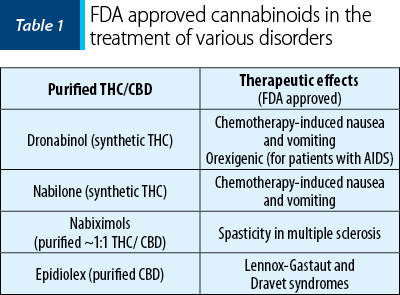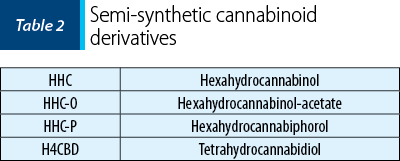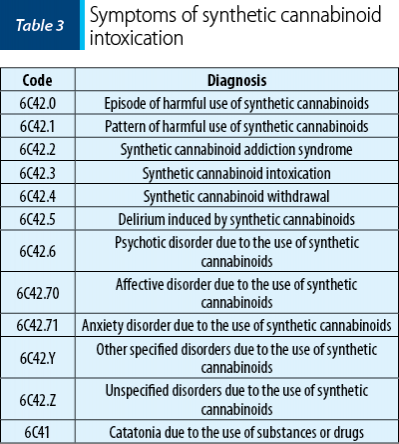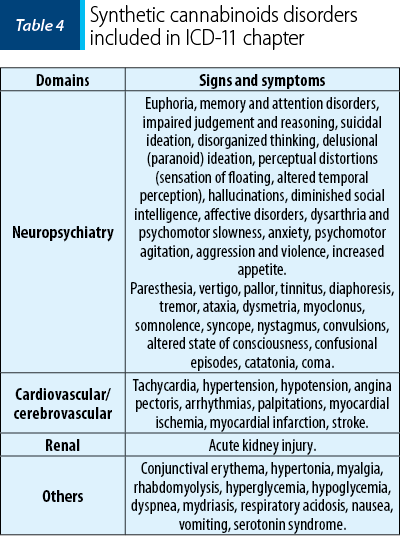Of all illicit psychoactive substances, cannabis is the most widely consumed drug (4% of the world’s population, annually). Since 2004, we have been dealing with a new major international problem, represented by cheap synthetic cannabinoids with an extremely diverse chemical structure that are not regulated by law. In recent years, a new chapter dedicated to semi-synthetic cannabinoids has appeared in response to legislative reforms in the US. HHC, HHC-O, HHC-P and H4CBD are only some of the drugs in this new class. The “Dream Factory” file (over 100,000 vaping devices and edibles that contained semi-synthetic cannabinoids sold to the general population in Romania) is an excellent example of legal and regulatory deficiencies regarding new psychoactive substances consumption. From the studies available and anecdotal reports from consumers, HHC provides the sensation of pleasure and relaxation, similar to the natural analogue (THC-like effects). In vitro testing of the affinity of Δ9-THCP (semi-synthetic cannabinoid) for CB1 demonstrated a 30-fold higher value than Δ9-THC, which means a higher potency and risk of adverse effects. The use of synthetic cannabinoids is correlated with a higher incidence of psychotic disorders (acute/transient, persistent/chronic “spiceophrenia” or relapses/exacerbations of preexisting psychotic disorders). Like other new psychoactive substances, semi-synthetic and synthetic cannabinoids cannot be detected using standard toxicology tests. Only liquid or gas chromatography mass spectrometry can be used for these drugs (LC-MS/ GC-MS). The treatment of intoxication is nonspecific, supportive and symptomatic, preferably multidisciplinary. Taking into account the availability and consumption trends in Romania, the identification and monitoring of semi-synthetic and synthetic compounds represent a legal, pharmacological and toxicological challenge. Sustained efforts to investigate HHC and related semi-synthetic and synthetic compounds are needed to better describe these molecules and to be able to train medical personnel to address the disorders caused by these new substances. The health risks are still unknown, and severe adverse effects, accidents and fatal overdoses can occur.
Canabinoidele şi provocările generate de derivaţii lor semisintetici
Cannabinoids and the challenges of new synthetic derivatives
First published: 29 noiembrie 2023
Editorial Group: MEDICHUB MEDIA
DOI: 10.26416/Psih.75.4.2023.8927
Abstract
Rezumat
Dintre toate substanţele psihoactive ilicite, canabisul este cel mai consumat drog (4% din populaţie la nivel mondial, anual). În ultimii ani a apărut un nou capitol dedicat canabinoidelor semisintetice, ca răspuns la reformarea legislativă din SUA, unde s-a decis cultivarea de cânepă la nivel industrial. Derivaţii semisintetici (care respectă structura de bază a THC, sunt prezenţi în mod natural şi pot fi, de asemenea, sintetizaţi în laborator) pot fi produşi din CBD extras din plantele de canabis cu conţinut scăzut de THC („light cannabis”). Se explică, astfel, apariţia dosarului „Fabrica de vise” – comercializarea de dispozitive electronice de vapat şi diverse dulciuri (prăjituri, jeleuri, drajeuri) care conţineau canabinoizi semisintetici (HHC, HHC-P, HHC-O, H4CBD, THC-P) şi canabinoizi naturali (THC). Canabinoizii sintetici prezintă, pe lângă efectul euforizant asemănător celui indus de THC, şi o predispoziţie către tulburări psihotice, manifestate în special prin simptome pozitive (delir, halucinaţii şi gândire sau comportament dezorganizat). Intensitatea simptomatologiei este dependentă de doza utilizată. Ca şi celelalte substanţe psihoactive noi, canabinoizii semisintetici şi sintetici nu pot fi detectaţi utilizând testele uzuale toxicologice. Pentru identificarea lor, se poate utiliza doar spectrometria de masă, prin cromatografie lichidă sau cu gaz (LC-MS/ GC-MS). Tratamentul intoxicaţiei este nespecific, de tip suportiv (cu susţinerea funcţiilor vitale şi a echilibrului hidroelectrolitic) şi simptomatic, de preferat multidisciplinar. În contextul actual şi luând în considerare particularităţile disponibilităţii şi trendului de consum în România, identificarea şi monitorizarea compuşilor semisintetici şi sintetici reprezintă o adevărată provocare legală, farmacologică şi toxicologică. Sunt necesare eforturi susţinute pentru investigarea HHC şi a compuşilor înrudiţi semisintetici şi sintetici, pentru a descrie mai bine aceste molecule şi pentru a putea instrui personalul medical asupra abordării tulburărilor provocate de aceste noi substanţe. Riscurile pentru sănătate sunt încă necunoscute, putând apărea efecte adverse severe, accidente şi supradoze cu efect letal.
Cannabis, semi-synthetic and synthetic cannabinoids
Of all illicit psychoactive substances, cannabis is the most widely consumed drug (4% of the world’s population, annually). Cannabinoids are chemical compounds that interact with CB1 and CB2 receptors(1). The human body is capable of synthesizing its own cannabinoids called endocannabinoids (anandamide and 2-arachidonoylglycerol; 2-AG) and together with the two receptors form the endocannabinoid system(2).
Cannabis, a naturally occurring drug, comes in the form of dried leaves or buds from the Cannabis sativa plant(1). This plant has over 500 chemical compounds, with over 100 cannabinoids identified. Due to the need to meet safety standards with full description of the active substance with pharmacokinetics, pharmacodynamics properties, therapeutic dose, toxic dose, beneficial effects, adverse effects and drug interactions, marijuana has never been accepted by the FDA. In contrast, the pure cannabinoid compounds Δ9-THC (Δ9-tetrahydrocannabinol) and CBD (cannabidiol) as well as synthetic analogues that respect their chemical structure (dronabinol, nabilone) are FDA-approved in the treatment of various disorders (Table 1)(2).
Δ9-THC, first identified in the early 1960s by Raphael Mechoulam, is the main cannabinoid compound responsible for psychoactive effects. CBD is the constitutional isomer of Δ9-THC that is inert psychoactive (or weakly psychoactive) and is the second most abundant cannabinoid, after Δ9-THC, in Cannabis sativa(3).

After the identification of Δ9-THC as the main psychoactive component in cannabis, the chemical and pharmacological industry searched for more potent analogues. These synthetic compounds (over 250 currently) are produced in illegal laboratories and sold recreationally. Their use carries major risks compared to the natural analogue Δ9-THC which must be consumed in very high doses to produce severe adverse effects(3).
Synthetic cannabinoids are preferred by young males, who choose these substances over the natural analogue due to low cost, legal status, increased availability of the substance, and the lack of detection with standard drug tests(4). This category of substances is used especially by homeless people and inmates(5).
Since 2004, we have been dealing with this major international problem, cheap synthetic cannabinoids with an extremely diverse chemical structure that are not regulated by law. In recent years, a new chapter dedicated to semi-synthetic cannabinoids has appeared in response to legislative reforms in the USA(6). In 2018, the US approved the bill to legalize cannabis with a low THC content (maximum 0.3%, also known as “light cannabis”) which is a legal substitute for cannabis with a high THC content (“skunk”)(3).
This is the starting point for a new category of legal drugs: semi-synthetic cannabinoids. Unlike the synthetic cannabinoid agonists found in “Spice” or “Shop” products, semi-synthetic derivatives (THC-like structure, naturally occurring, and which can also be synthesized in the laboratory) can be produced from CBD extracted from light cannabis(7).
The EMCDDA 2023 report reveals that, last year, in the category of new psychoactive substances (930 currently monitored), synthetic cannabinoids represent approximately 60% of new substances introduced to the market (24 new synthetic cannabinoids out of a total of 41 new psychoactive substances in 2022). From the category of synthetic cannabinoids, there are first reports of semi-synthetic cannabinoid derivatives (Table 2)(8).

In the 15-34 years old age group, Romania has the highest prevalence of new psychoactive substance users in Europe (5.1%). The EMCDDA issued a warning (in 2021) about the presence of cannabinoids in food products (especially sweets with cannabis extract) that can be consumed by the general population without restrictions, including children(8).
On 19 September 2023, it took place the operation known as the “Dream Factory”, where several people who constituted an organized criminal group responsible for the production and distribution of new psychoactive substances in 23 counties in Romania were detained. It is estimated that, over a period of approximately one year, the company responsible for these acts, which was based in Iaşi County, produced over 100,000 electronic vaping devices and various sweets (cakes, jellies) that contained semi-synthetic cannabinoids (HHC, HHC-P, HHC-O,H4CBD, THC-P) and natural cannabinoids (THC)(9).
Although the compounds have been present on the drug market for over a year, Romania has not yet adopted a clear legal attitude towards semi-synthetic cannabinoids, unlike other countries in Europe that have banned HHC starting from mid-2023.
This is one of the most important moments in the history of legal drugs since the introduction of “Spice” 15 years ago. The consumption and availability are probably much higher than those reported by the EMCDDA(7).
Like THC, HHC provides the sensation of pleasure and relaxation sought by consumers. Researching the few studies currently available and anecdotal reports from consumers, HHC appears to have effects similar to the natural analogue (data in the literature are not yet sufficient to confirm this, and extrapolations from synthetic analogues will be made)(10).
In Europe, there is an increased interest in this semi-synthetic derivative both from “old” cannabis users and from inexperienced users, due to the effects, the uncertain legal status, the increased availability, and the attractive price. From an organoleptic, visual and olfactory point of view, cannabinoids are identical(7).
Cannabimimetics were synthesized with the aim of analyzing the endocannabinoid system, the most famous compound being JWH-018 (AM-678, component of “Spice”), named after the chemist John W. Huffman, for the purpose of toxicological detection of Δ9-THC (military personnel, performance athletes).
Natural and designer HHC was first described and synthesized by Adams in 1940, entering the illegal drug market in the US and Europe in late 2021(11,12). It can be consumed by inhalation, ingestion (“edibles”) or sublingually, representing a legal, undetectable and cheap alternative to THC(13,14).
HHC is the first semi-synthetic cannabinoid derived from CBD reported in the European Union and monitored as a new psychoactive substance (from 21 October 2022). There are currently few data on the pharmacological properties of HHC and the prevalence of use(3).
HHC has cannabimimetic effects, but with a lower potency than Δ9-THC(14). Through the cyclization process, CBD is transformed into a mixture of Δ8/Δ9-THC. The next step is catalytic hydrogenation by which racemic HHC is obtained consisting of two epimers, (9R)-HHC and (9S)-HHC(6,14).
Using a hydrogen atom transfer reduction model, (9R)-HHC is obtained as the major product. The catalytic hydrogenation process results in variable proportions between the two diastereomers(12).
(9R)-HHC (“equatorial” methyl isomer) and (9S)-HHC (“axial” methyl isomer) thus represent derivatives of Δ9- and Δ8-THC. These two compounds are still poorly studied and occur naturally in hemp seeds in small amounts. Like THC, HHC is a partial agonist at CB1 and CB2 cannabinoid receptors(12,15).
Preclinical studies demonstrate that the receptor affinity and potency of the (9R)-HHC diastereoisomer is similar to that of Δ9-THC. (9R)-HHC exhibits THC-like pharmacological properties, compared to the (9S)-HHC diastereoisomer which exhibits a lower potency. (9R)-HHC is 17 times more potent at the CB1 receptor and nine times more potent at the CB2 receptor than (9S)-HHC. The higher the diastereomeric ratio between the two compounds, the more pronounced are the psychoactive effects. Given that the purity of new psychoactive substances cannot usually be tested, there is a marked variability in the psychoactive effects of different HHC users(6,12).
To test the cannabimimetic characteristics of a compound, the quadruple pharmacological test is used with the following parameters: spontaneous activity testing, catalepsy (immobility index), analgesic effect, and changes in rectal temperature. Cannabimimetic activity is suggested by decreased locomotor activity, catalepsy, analgesia and hypothermia(3,16). This quadruple pharmacological test for cannabimimetic effects reveals that (9R)-HHC causes reduction in spontaneous activity (hypolocomotion), analgesia and hypothermia(3). A recently discovered synthetic analogue of Δ9-THC, Δ9-THCP (Δ9-tetrahydrocannabiphorol), also exhibits the ability to induce hypomotility, analgesia, catalepsy, and rectal temperature reduction(3,16). The potency of HHC in producing the tetrad of effects is lower than Δ9-THC or Δ9-THCP(3).
The essential element for the biological activity of cannabinoids at the CB1 receptor is the length of the alkyl (unsaturated, “-R”) side chain(16).
Basically, the potency of a cannabimimetic compound is dependent on the length of the side chain of the molecule (potency and side chain length are directly proportional). Thus, synthetic analogues such as Δ9-THCP, which has a 7-carbon side chain, will result in superior cannabimimetic effects than Δ9-THC (which has only five carbon atoms on the alkyl side chain in its structure). This fact increases the receptor affinity of Δ9-THCP for CB1 and, thus, the potency of the synthetic analogue. Studies have shown that Δ9-THC-O (Δ9-tetrahydrocannabinol acetate) is also more potent than Δ9-THC(16,17). In vitro testing of the affinity of Δ9-THCP for CB1 demonstrated a 30-fold higher value than Δ9-THC. Δ9-THCP is at least as biologically active as Δ9-THC, but at lower doses(16). Multiple homologues of Δ8-THC have also been synthesized that have more than five carbon atoms on the side chain and, implicitly, they have a much higher potency than Δ9-THC(16).
Synthetic cannabinoids act not only on the endocannabinoid receptor system, but also on serotonin, acetylcholine, glycine and glutamate receptors. It is possible that the psychoactive effect of these compounds is also achieved through these secondary actions(4).
Clinical, laboratory testing and treatment
ICD10-CM classifies these synthetic cannabinoids as other psychoactive substances without a clear definition (F19). ICD11 has a distinct chapter for synthetic cannabinoids (6C42, Table 3) which are described as various chemical compounds that exhibit potent agonistic activity on the endocannabinoid receptor system(18). Besides the THC-like euphoric effect, synthetic cannabinoids show a predisposition to psychotic disorders manifested mainly by positive symptoms (delirium, hallucinations and disorganized thinking or behavior). The symptoms of synthetic cannabinoid intoxication are similar with those of cannabis intoxication, presenting the same manifestations but with a higher prevalence for delirium and acute psychotic disorder (Table 4)(5,18). The intensity of symptoms is dose-dependent. The effects desired by consumers are euphoria, tranquility, relaxation, perceptual distortions (“geometric/fractal figures”, “trailing”), hallucinations, altered state of consciousness, disinhibition, anxiolytic, sedative and antidepressant effects(4,5).

The adverse effects experienced by users are more intense with synthetic cannabinoids than natural cannabis, and there are also more emergency departments presentations(5).
Psychotic disorders induced by synthetic cannabinoids can be acute/transient, persistent/chronic (“spiceophrenia”) or relapses/exacerbations of preexisting psychotic disorders(4).
Vaping liquid can contain various substances, including synthetic and semi-synthetic cannabinoids (Δ8-THC, Δ10-THC, HHC), and vaping products and e-cigarettes can cause EVALI (E-cigarette or vaping use-associated lung injury)(19).
Cannabimimetic compounds may also have therapeutic benefits. If Δ9-THC is responsible for the psychoactive effects of cannabis, CBD is an antioxidant, anti-inflammatory and anticonvulsant compound, counteracting the negative effects of Δ9-THC(3,16). CBD is also thought to have neuroprotective, analgesic, anxiolytic and antipsychotic effects(11). Synthetic cannabinoids usually do not contain CBD and, therefore, they lack the protective effects of this compound(4,5).
Natural, semi-synthetic and synthetic cannabinoids exhibit anti-tumoral properties through an anti-angiogenic (VEGF inhibitor) mechanism. Angiogenesis is an important regulatory step in tumor growth and dissemination. The mechanism is indirect, through the peripheral cannabinoid receptors (CB2) which are located almost exclusively in the immune system(20).

Currently, HHC is being studied in the treatment of ocular hypotony and colon cancer(12).
Like other new psychoactive substances, semi-synthetic and synthetic cannabinoids cannot be detected using standard toxicology tests. There are still no rapid immunoanalytical detection methods for these compounds(3,6). Only liquid or gas chromatography mass spectrometry can be used to identify semi-synthetic and synthetic cannabinoids (LC-MS/ GC-MS)(13).
Drugs containing synthetic cannabinoids usually contain several types of substances from the same class or even substances from other pharmacological classes, which can lead to the risk of interaction between different psychoactive substances with a synergistic effect, abuse and alteration of the user’s somatic status(4).
The treatment of intoxication is nonspecific, supportive (vital functions and hydroelectrolytic parameters) and symptomatic, preferably multidisciplinary. There is no antidote for synthetic cannabinoid intoxication(5). For mild and moderate intoxication, patient’s monitoring and adequate hydration are sufficient. Benzodiazepines are useful for anxiolysis and psychomotor agitation. For psychotic symptoms or psychomotor agitation and aggression, antipsychotics can be used (inconclusive data on the choice of antipsychotic, but clozapine and olanzapine are the most frequently used drugs). In severe cases, cardiovascular, cerebrovascular, neurological, psychiatric and renal disorders may be associated (comorbidities must also be treated)(4,5).
There are no approved medications for synthetic cannabinoid withdrawal or addiction, but studies show relatively good results with baclofen and naltrexone(4).
Discussion and conclusions
Cannabis and its derivatives are extremely popular products due to their psychoactive effects, being sold both in stores and on the internet(3). Most drugs are found on the dark web and deep web which requires an “open-source” web browser capable of data encryption for protection and anonymity. Currently, however, there are sites even on the surface web where you can purchase cannabinoid compounds, both natural (“light cannabis”) and semi-synthetic (HHC, HHC-O, TCHP and combinations of compounds) accessible to the general public(21).
Taking into account the availability and consumption trends in Romania, the identification and monitoring of semi-synthetic and synthetic compounds represent a legal, pharmacological and toxicological challenge. Sustained efforts to investigate HHC and related semisynthetic and synthetic compounds are needed to better describe these molecules and to be able to train medical personnel to address the disorders caused by these new substances. The health risks are still unknown, and severe adverse effects, accidents and fatal overdoses can occur(14).
Bibliografie
- Saunders JB (Editor). Addiction medicine. Second edition. Oxford: Oxford University Press; 2016, 641 p. (Oxford specialist handbooks).
- Stahl SM (Editor). Stahl’s Essential Psychopharmacology: Neuroscientific Basis and Practical Applications. Fifth edition. Cambridge University Press; 2021, 644 p.
- Russo F, Vandelli MA, Biagini G, Schmid M, Luongo L, Perrone M, et al. Synthesis and pharmacological activity of the epimers of hexahydrocannabinol (HHC). Sci Rep. 20238;13:11061.
- Corazza O, Roman-Urrestarazu A (Editors). Handbook of novel psychoactive substances: what clinicians should know about NPS. New York, NY: Routledge; 2019.
- Bowden-Jones O, Abdulrahim D. Club Drugs and Novel Psychoactive Substances: The Clinician’s Handbook [Internet]. 1st Ed. Cambridge University Press; 2020. https://www.cambridge.org/core/product/identifier/9781911623106/type/book
- Ujváry I. Hexahydrocannabinol and closely related semi-synthetic cannabinoids: A comprehensive review. Drug Test Anal. 2023;10.1002/dta.3519.
- European Monitoring Centre for Drugs and Drug Addiction. EMCDDA technical expert meeting on hexahydrocannabinol (HHC) and related cannabinoids [Internet]. 2022 [cited 2023 Oct 23]. https://www.emcdda.europa.eu/news/2022/emcdda-technical-expert-meeting-hexahydrocannabinol-hhc-and-related-cannabinoids_en
- European Monitoring Centre for Drugs and Drug Addiction. European drug report 2023 [Internet]. LU: Publications Office; 2023 [cited 2023 Oct 23]. https://data.europa.eu/doi/10.2810/161905
- Operaţiunea Fabrica de vise [Internet]. [cited 2023 Oct 23]. https://www.politiaromana.ro/ro/stiri/operatiunea-fabrica-de-vise
- What Do Scientists Know About Hexahydrocannabinol, or HHC? [Internet]. [cited 2023 Oct 23]. https://www.webmd.com/mental-health/addiction/what-is-hhc
- Docampo-Palacios ML, Ramirez GA, Tesfatsion TT, Okhovat A, Pittiglio M, Ray KP, et al. Saturated Cannabinoids: Update on Synthesis Strategies and Biological Studies of These Emerging Cannabinoid Analogs. Molecules. 2023;28(17):6434.
- Nasrallah DJ, Garg NK. Studies Pertaining to the Emerging Cannabinoid Hexahydrocannabinol (HHC). ACS Chem Biol. 2023;18(9):2023–9.
- Schirmer W, Auwärter V, Kaudewitz J, Schürch S, Weinmann W. Identification of human hexahydrocannabinol metabolites in urine. Eur J Mass Spectrom (Chichester). 2023;14690667231200140.
- Graziano S, Varì MR, Pichini S, Busardo FP, Cassano T, Di Trana A. Hexahydrocannabinol Pharmacology, Toxicology, and Analysis: The First Evidence for a Recent New Psychoactive Substance. Curr Neuropharmacol. 2023;21(12):2424–30.
- Casati S, Rota P, Bergamaschi RF, Palmisano E, La Rocca P, Ravelli A, et al. Hexahydrocannabinol on the Light Cannabis Market: The Latest “New” Entry. Cannabis Cannabinoid Res. 2022;10.1089/can.2022.0253.
- Citti C, Linciano P, Russo F, Luongo L, Iannotta M, Maione S, et al. A novel phytocannabinoid isolated from Cannabis sativa L. with an in vivo cannabimimetic activity higher than Δ9-tetrahydrocannabinol: Δ9-Tetrahydrocannabiphorol. Sci Rep. 2019;9:20335.
- Moody MT, Ringel MM, Mathews CM, Midthun KM. Determination of Cross-Reactivity of Contemporary Cannabinoids with THC Direct Immunoassay (ELISA) in Whole Blood. Journal of Analytical Toxicology. 2022;46(8):844–51.
- ICD-11 for Mortality and Morbidity Statistics [Internet]. 2022 [cited 2022 May 30]. https://icd.who.int/browse11/l-m/en
- Meehan-Atrash J, Rahman I. Cannabis vaping: existing and emerging modalities, chemistry, and pulmonary toxicology. Chem Res Toxicol. 2021;34(10):2169–79.
- Thapa D, Lee JS, Heo SW, Lee YR, Kang KW, Kwak MK, et al. Novel hexahydrocannabinol analogs as potential anti-cancer agents inhibit cell proliferation and tumor angiogenesis. European Journal of Pharmacology. 2011;650(1):64–71.
- Bearly Legal HempTM Delta 8. Legal THC. Look for the Bear [Internet]. [cited 2023 Oct 23]. https://www.bearlylegalhemp.com/
Articole din ediţiile anterioare
Canabidiolul – zeci de ani de cercetare şi utilizările clinice actuale
Deşi majoritatea cercetărilor referitoare la canabis s-au concentrat asupra delta-9-trans-tetrahidrocanabinolului (THC), recent alte componente ale...
Tulburările psihotice în ICD-11 comparativ cu ICD-10
Capitolul privitor la psihoze din ICD-11 prezintă modificări semnificative în raport cu ICD-10, începând cu plasarea în ordinea prezentării tulbură...